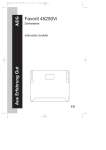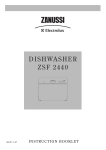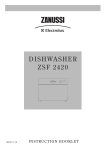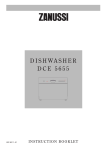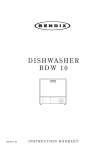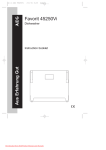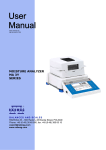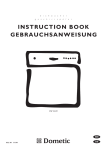Download Zanussi ZDC 5465 Specifications
Transcript
822 61 10-22 Contents For the Installer For the user Safety Information 3 Description of the appliance 4-5 Technical Specifications 15 Unpacking 16 - Damages - Use - Spray arm - Coarse filter/microfilter - Fine filter - Detergent dispenser - Rinse aid dispenser - Water softener Installation The control panel 6 Adjusting the water softener 7 - Position - Measurements for fitting a wooden door - Preparing the outer door - Mounting plate - Fitting the outer door - Fitting protective and cap strips - Mounting the dishwasher - Water inlet - Water drainage - Power supply - Switching the rinse aid dispenser off Programme chart 8 Using the appliance 9 - Starting the programme - Stopping the programme temporarily - Cancelling the programme - Pause function - Cancelling the drying phase - Switching the dishwasher off Loading and unloading 10 Maintenance and cleaning 11 Something Not Working 12 Service 13 - Service and Spare Parts - Customer Care Department Information for test centres 13 Guarantee Conditions 14 17-23 Guide to use the instruction book The following symbols will be found in the text to guide you throughout the instructions: Safety information Step by step instructions Hints and tips Environmental information -2- Safety information Before installing and first using the dishwasher, read this instruction booklet carefully, including its hints and warnings. To avoid unnecessary mistakes and accidents, it is important to ensure that all people using the dishwasher are thoroughly familiar with its operation and safety features. Save these instructions and make sure they remain with the dishwasher if it is moved or sold, so that everyone using it through its life can be properly informed on appliance use and safety. Installation and servicing ● All installation and service work done on the product must be carried out by a qualified technician. Work performed by persons with inadequate knowledge may adversely affect the satisfactory functioning of the product and may cause personal injury or damage. Before any work is carried out on the dishwasher, it must be isolated from the electrical supply. To do this the power plug must be removed from the wall socket. ● Water connection shall be made via an easily accessible stopcock. ● The power cable must be plugged into an earthed socket, which must to be easily accessible. Permanent installation must only be carried out by an authorized electrician. ● If the power cable is damaged, it must be replaced by a special cable or assembly available from the manufacturer or its service agent. ● Make sure that the power cable is not nipped or otherwise damaged and that the hoses do not get crushed or kinked when moving the dishwasher in connection with installation or cleaning etc. ● Servicing and possible repairs must be carried out by a service company authorized by the supplier. Use only spare parts supplied by these. Never try to repair the dishwasher yourself. ● The dishwasher should be used by adults only. Do not let children play with the controls or other parts of it. ● Remember that the plastic bags included in the packaging can be fatal playthings for small children. ● Keep all detergents in safe place out of children´s reach. ● Prevent children from sitting, swinging or standing on the open door. During Use ● Only use detergent specifically designed for use in dishwashers. ● Do not place sharp knives with their points upwards. It is much safer to lay them horizontally in the basket. ● If you take any dishes out of the dishwasher before the end of the dishwashing cycle, it is extremely important to rinse them thoroughly under running water to remove any remaining detergent. ● The water safety system protects against water damages. The following requirements must be fulfilled: - The dishwasher must be electrically connected when it is switched off. - The dishwasher must be correctly installed. - Always shut off the water supply whenever the dishwasher is left unattended for an extended period. ● Child Safety ● ● This dishwasher is designed solely for washing household utensils suitable for machine washing. Using it for other purposes could lead to physical injury or damage to property and invalidate the guarantee. Avoid opening the door while the dishwasher is running, as hot steam may escape. In the event of flooding or leakage, switch off the water supply immediately by closing the stopcock and disconnect the power supply by unplugging the power cable or removing the fuse. When removing the electrical plug, grip the plug, not the cable. Disposal - packaging: All materials used in packaging this appliance are environmentally-friendly. The various plastics used are identified and can be recycled: ● PE stands for polyethylene, which is used for the bag around the appliance and the bag in which these instructions were supplied. ● PS stands for polystyrene (moulded), which is used for the sections of packaging needed to cushion the appliance. The cardboard components of the packaging are made from recyclable paper and should be taken to a collection point for recycling. The appliance contains plastic and rubber components. These have identifying marks to show what they are made from, so they can be recycled or disposed of properly at the end of the appliance's life cycle. The materials are identified according to international standards. - old appliances: At the end of the appliance's useful life, disconnect the electrical plug from the power supply, then cut the electrical cable at the point where it enters the appliance. Make quite sure that children will not be able to play with it. -3- 822 61 10-22 Description of the appliance 4 5 -4- Spray arm (1) It is important to keep all the holes in the spray arm clear. A clogged hole can seriously affect washing efficiency. If the spray arm needs cleaning, unscrew the nut anticlockwise, remove the washer and lift off the spray arm. Clear the holes and shake out any food remnants. Do not fill the rinse aid dispenser with liquid detergent. Zanussi recommends the use of Finish dishwasher detergent and Rinse Aid. Water softener (6) This dishwasher is equipped with a water softener for hard water. The lime in hard water causes white deposits to occur on dishes and to the interior of the dishwasher. To prevent this, the water has to pass through a special container where the hardness is removed. Since the water softener uses dishwasher salt, you will have to refill the salt container after a certain number of dishwasher cycles. Coarse filter/microfilter (2) The purpose of the coarse filter is to catch large objects such as toothpicks and pieces of eggshell. Make sure that the filter is always clean. Turn the coarse filter anticlockwise. Lift it out and rinse it under running water whenever necessary. Fine filter (3) It is extremely important, that the salt container is filled up with the dishwasher salt before using the dishwasher for the first time. It is just as important to keep this filter clean. A dirty or clogged filter will always impair washing efficiency. The fine filter can easily be lifted out for cleaning when you have removed the coarse filter. The indicator light on the control panel is lit when the container requires refilling. Detergent dispenser (4) 1. Unscrew the filler cap to the salt container anticlockwise. Open the lid to the dispenser by pressing the lid catch towards the compartment. Consult the instructions on the detergent packet, fill the compartment accordingly and close the lid. Remember that the instructions usually refer to full-size dishwashers, for example when using detergent tablets, it is sufficient to use just half a tablet. Pre-wash detergent is poured into the smaller compartment to the left when needed. This detergent is used during the prerinsing. Make sure that nothing prevents the lid from opening. Only use detergents specially designed for dishwashers. Rinse aid dispenser (5) 2. Fill the salt container with water (only the first time). 3. Fill the container with dishwasher salt, using the funnel supplied. 4. Remove the funnel and wipe off any spillage around the filler opening. 5. Screw the filler cap back properly in place. The water softener is now ready for the first load of dishes. Always make sure that there is dishwasher salt in the container, which holds about 1 litre. How to adjust the water softener, see chapter ”Adjusting the water softener”. Use of rinse aid will result in cleaner and faster drying of the load, since it helps water and residues to run off. Too much rinse aid may result in streakiness, too little may cause white spots. The dispenser holds about 150 ml. This is enough for approx. 60 wash cycles, depending on the dosage setting. Adjust the dosage setting according to the hardness of the water. You can set the dosage between 1 - 6, the appliance is factory set to 1. Begin at the lowest dosage setting and increase if necessary by turning the setting arrow with e.g. the handle of a spoon. The indicator light on the control panel is lit when the dispenser requires refilling. 1. Open the lid to the dispenser by pressing the lid catch towards the compartment and lift the lid. 2. Fill up with rinse aid; do not overfill. 3. Wipe off any spillage carefully to prevent excessive foaming during the next wash programme. 4. Close the lid and press until it locks again. -5- Only use special salt for dishwashing machines, ordinary domestic salt, especially table salt, can damage the water softener. The control panel Control lamps Indicator lamps A Water softener button On/Off button Buzzer button Rinse aid button Programme buttons Combination buttons ”A” In addition to selecting a programme, you can press these two buttons to adjust the setting of the water softener, switch off the buzzer and rinse aid dispenser. Control lamps: Indicator lamps: Shows • Wash cycle in progress Shows that • Refilling of salt container is necessary top lamp • Rinse cycle in progress middle lamp • Drying in progress lowest lamp • Refilling of the rinse aid dispenser is necessary • The selected programme has finished Switching the buzzer off Before switching the buzzer off all programmes must have been completed. 1. Press in the On/Off button. 2. Press the combination buttons simultaneously and hold them pressed in. When the first three programme indicator lamps starts to flash, you can let go of the buttons. 3. Press the buzzer button once. The lamp for the buzzer button starts to flash and the lamp for the ended programme cycle is lit. Press the button once more and the lamp for the ended programme cycle goes out. Now the buzzer is off. 4. Press out the On/Off button to complete the setting. To reset the function, follow steps 1 and 2 above and then press the buzzer button twice, until the end of programme lamp is illuminated again. -6- Adjusting the water softener To prevent limescaling on the dishes and to the interior of the dishwasher, the dishes must be washed with soft water. Contact your local Water Authority to find the exact water hardness level for your area. This dishwasher is equipped with a water softener, where tapwater which is harder than 4 °d (german degree) is softened. The water softener has 5 settings: Adjust the water softener according to the table below for the water hardness level for your area. Water hardness level Setting on the water softener Number of light and sound signals °d 1) mmol/l 2) > 24 4,2 5 5 18 - 24 3,2 - 4,2 4 4 12 - 18 2,1 - 3,2 3* 3 4 - 12 0,7 - 2,1 2 2 below 4 below 0,7 1 no salt is needed 1 In both of the following settings the dishwasher must be switched off and all programmes completed. See chapter ”Using the appliance” for information on how to complete the programme. Switching the rinse aid dispenser off 1. Press in the On/Off button. 2. Press the combination buttons simultaneously and hold them pressed in. When the first three programme indicator lamps starts to flash, you can let go of the buttons. If dishwasher detergent with rinse aid is used, you can switch off the rinse aid dispenser and the lamp that indicates that the rinse aid dispenser is empty. 3. Press the water softener button once. The lamps for the water softener and for the end of programme starts to flash and a buzzer will sound, unless it is switched off. - The number of flashes for the end of programme and sound signals are equivalent with the set water hardness level. - This sequence of flashes and sound is repeated several times after a few seconds pause. 4. The water hardness level is raised by 1 step every time you press the water softener button. 1. Press in the On/Off button. 2. Press the combination buttons simultaneously and hold them pressed in. When the first three programme indicator lamps starts to flash, you can let go of the buttons. 3. Press the rinse aid button once. The lamp for the rinse aid button starts to flash and the lamp for the end of programme is lit. Press the button once more and the lamp for the ended programme cycle goes out. Now the function for the rinse aid dispenser is off and the control lamp is out. 4. Press out the On/Off button to complete the setting. After hardness level 5 comes hardness level 1. 5. Press the On/Off button when the required water hardness level is selected. This saves the selection. If the setting 1 is chosen, the salt indicator lamp is not lit. 1) german degree of measurement for the water hardness 2) millimol, internationel unit for water hardness *) factory setting -7- To reset the function, follow steps 1 and 2 above and then press the rinse aid button twice, until the end of programme lamp is illuminated again. Programme chart Type of dishes Type of soil: • heavily soiled Coffee cups, All types of delicate items dishes All types of dishes Plates and cooking pots • normaly soiled • normaly soiled • lightly soiled • lightly soiled 4) • dried-on food • dried-on food remnants remnants especially eggwhite and starch Suitable programme: INTENSIVE 70° C Programme cycle: 1) Pre-wash Washing 2 x rinses Final rinse Drying NORMAL 65° C Pre-wash Washing Rinse Final rinse Drying BIO 55° C 3) Pre-wash Washing Rinse Final rinse Drying QUICK 50° C GLASS 40° C Washing Rinse Final rinse - Washing Rinse Final rinse - PRERINSE Prerinse - Consumption figures: 2) Washing time with drying: 112 minutes 92 minutes 150 minutes 35 minutes 30 minutes 7 minutes Drying time: 13 minutes 13 minutes 54 minutes — — — 1,15 kWh 0,80 kWh 0,63 kWh 0,40 kWh 0,35 kWh 0,01 kWh 9 litres 7 litres 7 litres 6 litres 6 litres 1,8 litres Energy: Water: 1) Different parts of the wash programme may not sound the same, because the wash action is more intensive at some stages. 2) Consumption figures have been calculated for nominal conditions. The figures can vary depending on inlet water temperature and how full the main and cutlery basket are. 3) Consumption figures and performance is according to the BIO programme cycle. 4) Prerinse is used if you want to wait until you have a full load. This cycle rinses the load and keeps it moist, making the main wash easier later on. No detergent should be used. All programmes begin with a drain. Dishwashing detergent in tablet form is not suitable for use in the Quick and Glass programme cycles because some tablets cannot develop their full cleaning power during short programmes. -8- Using the appliance Starting the programme Pause function 1. Scrape or rinse off solid food remnants. With the pause function the programme can be temporarily interrupted for a short period of time. 2. Load the dishwasher. (See the basket and loading). 1. Open the door and press the On/Off button. The programme stops. 3. Put the correct amount of detergent into the detergent dispenser and close the dispenser lid. 2. All lamps goes out. 4. Press in the On/Off button. All programme indicator lamps are lit. 3. When you want the programme to continue again, press the On/Off button once more and close the door. The programme continues. 5. Press in the required programme button (see programme chart). All other programme indicator lamps goes out. The programme should not be paused for any longer than necessary, because the water inside the dishwasher has cooled down and must be heated again which increases the power consumption. 6. Close the door. 7. Check the filters to see if they need to be cleaned when the dishwasher has finished the programme. Cancelling the drying phase In case you do not want to wait until the drying phase is completed, you can cancel it by opening the door. The drying phase is now cancelled. Stopping the programme temporarily 1. Open the door. The programme stops. 2. The programme indicator lamp is lit. Switching the dishwasher off 3. Close the door and the programme continues after about 6 seconds. Open the door carefully when the dishwasher is running, since hot steam may escape which could damage surrounding cabinetry and could cause an injury. Switch the dishwasher off when the end of programme buzzer sounds (approx. 15 seconds) or the end of programme lamp is lit. Cancelling the programme 1. Open the door and press the On/Off button. Be careful if you open the door immediately after the programme is finished, since hot steam may escape. 1. Open the door. 2. Press and hold in the combination buttons, the machine goes to starting position and all programme indicator lamps are lit. This dishwasher has a new feature called ”IMPULSE WASHING”. This washing system varies both the revolutions of the pump and the water pressure for more intensive cleaning of the dishes during the programme. That is why different sections of the programme cycle do not sounds the same. 3. Release the buttons. The programme is now cancelled and a new programme can be selected. If you switch the dishwasher off, the selected programme is not cancelled, it is only interrupted. When you start the dishwasher again, the programme will continue. -9- Loading and unloading the dishwasher How to load the dishes Baskets The illustration shows the dishwasher loaded with six place settings. Your own dishes are not likely to be identical to this load, but if you follow the advice below we are sure you will be pleased with the results. Main basket Cutlery basket ● Always place glasses, cups and bowls upside down. ● Incline deep dishes (soup plates etc.) so that the water can run off when drying. ● Make sure that the dishes do not rest against each other. This is particularly important in regard to the cutlery basket - nested spoons, etc. simply cannot be properly washed. The water must get at all the soiled surfaces. ● Make sure that cutlery with slender handles and other items do not protrude through the openings in the basket and prevent the spray arm from rotating. ● Never put silver and stainless steel objects together. When these metals come into contact with each other a chemical reaction occurs which stains the silver. ● China with a pattern applied on top of the glaze may not be suitable for machine washing as the colours may fade and lose their lustre. The same applies to cutlery with wooden or plastic handles. Make sure you always buy articles that are dishwasher proof. ● Silver and aluminum items tend to discolour when washed. Food remnants from egg and mustard often causes discolourations and stains on silver. Make sure to rinse off and remove food remnants on silver if it is not washed immediately after it has been used. ● Not all plastic articles are machine washable. If you are in doubt as to whether your plasticware can be machine washed, we suggest you check by washing a single item or else wash them by hand. ● When washing delicate items, select the programme with the lower wash temperature. ● Substances such as ketchup containing strong colouring agents can cause temporary discolouration to the interior of the dishwasher. Do not place sharp knives with their points upwards. It is much safer to lay them horizontally in the main basket. Unloading Hot dishes are sensitive to mechanical shocks. Always let the dishes cool down before unloading. The dishes dry faster if the door is opened slightly for a short time once the programme has finished. - 10 - Maintenance and cleaning Cleaning the filters Moving the dishwasher There are two filters, a coarse one and a fine one which should be cleaned after every wash. Lift out these filters which are in the base of the dishwasher and wash under running water. If you have to move the dishwasher (you are moving house, etc): 1. Unplug it. 2. Turn off the water tap. The dishwasher must not be used without the filters. Incorrect repositioning of the filters will produce poor washing results. 3. Remove the water inlet and discharge hoses. Avoid tilting the dishwasher during transportation. Cleaning of the filters is vital to ensure correct operation of the dishwasher. Protecting the dishwasher against freezing Cleaning the spray arm The holes in the spray arm must be kept free of scraps for the efficiency of the washing action. Inspect the spray arm regularly. When thorough cleaning is necessary, remove the spray arm by unscrewing the nut anti-clockwise, remove the washer and lift off the spray arm. Wash the spray arm with hot soapy water using a stiff saucepan brush if necessary to remove scraps. Re-assemble carefully, making sure the nut is secure. If the dishwasher is placed in an environment where the temperature sometimes falls below 0° C, there is a risk that the small amount of water which remains inside the parts of the dishwasher will freeze and damage it. To prevent this you should: 1. Turn off the water supply to the dishwasher. 2. Remove the water inlet and discharge hoses. 3. Make sure that there is dishwasher salt in the salt container for the water softener. Cleaning the cabinet Clean the outside surfaces of the appliance using a mild (non-abrasive) household cleaning product. Finish by removing remaining traces of the product with a damp cloth. Do not use cleaning products which contain alcohol (spirits), thinners and similar substances. If the dishwasher is not going to be used for some time, take the following precautions: 1. Unplug the dishwasher and turn off the water supply. 2. Fill up the rinse aid container. 3. Make sure the tub is clean by carrying out a wash programme (without any crockery) using Finish Dishwasher cleaner, then dry the inside thoroughly. 4. Leave the door ajar. Cleaning the outer door It is possible to remove the outer door from the plastic door in order to clean inside it if necessary. 1. Unscrew the screws that hold the guides in the upper corners of the plastic door. 2. The outer door should be supported when opened out in order to prevent the hinges from breaking off. 3. If necessary, the door can be removed completely by inserting a screwdriver or similar tool into the predrilled holes in the base of the housing to release the spring clips on the hinges. When mounting the outer door, snap the hinges into place and screw the guides back. - 11 - The appliance is only to be used and stored indoors at normal room temperature. The manufacturer accpets no responsibility for any frost damage. Something Not Working Before calling out an engineer, please check through the details below because some faults can be rectified easily without the need to call out an engineer. If an engineer is called to resolve a problem listed below or to repair a fault caused by incorrect installation or mis-use a charge will be made, even if the appliance is under guarantee. Fault Check The programme will not start. • • • • • • Is the door closed properly? Have you pressed the On/Off button? Is the water tap turned on? Is the dishwasher plugged in? Has the fuse blown? (Start with fuse in electrical plug). Is the previous programme finished? (See ”Using the appliance”). The dishwasher is not filling with water. • • • • • Is the water tap turned on? Has your domestic water supply been cut off temporarily? Is the water inlet hose kinked or blocked? Is the filter inside the inlet hose blocked? Is the water pressure too low? Water not discharged at end of cycle. • Did you open the door before the programme cycle was finished? • Is the previous programme finished? (See ”Using the appliance”). • Are the filters clogged? Dishes not washed satisfactorily. • • • • • • • • • Visible lime deposits or white film on the dishes. • Is the salt container empty? • Is the water softener not correctly adjusted? • Is the rinse aid dispenser empty or adjusted to too low dosage? The dishwasher is noisy. • Are the dishes rattling against each other? • Is the spray arm knocking against the dishes? Whistling sound when washing. • This is not a fault, try another brand of detergent. The dishes are not quite dry and are not shiny. • Is the rinse aid dispenser empty or adjusted to too low dosage? • Have the dishes been left too long inside the dishwasher? The door is difficult to close. • Is the dishwasher level? Has anything prevented the spray arm from rotating? Are the spray arm holes clogged? Were the dishes packed too close together? Are the filters clogged? Are the filters fitted correctly in place? Did you use enough detergent? Is the salt container cap properly closed? Did you select a programme with too low temperature? Is the rinse aid dispenser empty? If the end of programme indicator lamp is flashing, it is possible that you can solve the problem your self. When the problem is solved, press in the On/Off button and the programme continues. If the problem occurs again, contact your local Service Force Centre. If any other lamps flash contact and inform your local Service Force Centre. Fault Check The end of programme indicator lamp is flashing and a sound signal is emitted. • Is the water tap turned on? • Is the filter inside the inlet hose blocked? • Is the water inlet hose kinked or blocked? - 12 - Service Service and Spare Parts Customer Care Department In the event of your appliance requiring service, or if you wish to purchase spare parts, please contact your local Service Force Centre by telephoning: For general enquiries concerning your Zanussi appliance or for further information on Zanussi products, please contact our Customer Care Department by letter or telephone at the address below or visit our website at www.zanussi.co.uk 08705 929929 Customer Care Department Zanussi 55-77 High Street Slough Berkshire SL1 1DZ Tel: 08705 727727 * Your telephone call will be automatically routed to the Service Force Centre covering your post code area. For the address of your local Service Force Centre and further information about Service Force, please visit the website at www.serviceforce.co.uk Before calling out an engineer, please ensure you have read the details under the heading ”In the event of a fault”. When you contact the Service Force Centre you will need to give the following details: 1. Your name, address and post code 2. Your telephone number 3. Clear and concise details of the fault 4. The model and serial number of the appliance (found on the rating plate) 5. The purchase date * call to this number may be recorded for training purposes. Please note that a valid purchase receipt or guarantee documentation is required for in-guarantee service calls. Never attempt to repair the dishwasher yourself. Repairs carried out by unauthorized or inexperienced persons can cause injury or serious malfunctioning. Information for test centres The salt container and rinse aid dispenser shall be filled in accordance with this instruction manual. Before conducting the measurements the dishwasher shall be operated for one or two complete cycles using detergent and a clean load. Test standard: EN 50242 and EN 60704 Rated capacity: 6 place settings accordance EN 50242 Loading of basket: see chapter ”Loading the dishes” Test program: BIO 55° C Detergent (IEC type B): 15 gram in the dispenser + 3 gram in the pre-wash dispenser Rinse aid (type III): setting 3 Feed water pressure: minimum 0,8 bar, maximum 10 bar Faste water outlet: install according to figure below - 13 - Guarantee Conditions Standard guarantee conditions We, Zanussi, undertake that if within 24 months from the date of the purchase this Zanussi appliance or any part thereof is proved to be defective by reason only of faulty workmanship or materials, we will, at our option repair or replace the same FREE OF CHARGE for labour, materials or carriage on condition that: • The appliance has been correctly installed and used only on the electricity supply stated on the rating plate • The appliance has been used for normal domestic purposes only, and in accordance with the manufacturer’s instructions • The appliance has not been serviced, maintained repaired, taken apart or tampered with by any person not authorised by us • All service work under this guarantee must be undertaken by a Zanussi Service Force Centre • Any appliance or defective part replaced shall become the Company’s property • This guarantee is in addition to your statutory and other legal rights Home visits are made between 8.30am and 5.30pm Monday to Friday. Visits may be available outside these hours in which case a premium will be charged. Exclusions This guarantee does not cover: • Damage or calls resulting from transportation, improper use or neglect, the replacement of any light bulbs or removable parts of glass or plastic • Costs incurred for calls to put right an appliance which is improperly installed or calls to appliances outside the United Kingdom • Appliances found to be in use within a commercial environment, plus those which are the subject to rental agreements • Products of Zanussi manufacture which are not marketed by Zanussi European Guarantee If you should move to another country within Europe then your guarantee moves with you to your new home subject to the following qualifications: • The guarantee starts from the date you first purchased your product • The guarantee is for the same period and to the same extent for labour and parts as exists in the new country of use for this brand or range of products • This guarantee relates to you and cannot be transferred to another user • Your new home is within the European Community (EC) or European Free Trade Area • The product is installed and used in accordance with our instructions and is only used domestically, i.e. a normal household • The product is installed taking into account regulations in your new country Before you move please contact your nearest Customer Care centre, listed below, to give them details of your new home. They will then ensure that the local Service Organisation is aware of your move and able to look after you and your appliances. France Senlis +33 (0)3 44 62 29 99 Germany Nurnberg +49 (0)800 234 7378 Italy Pordenone +39 (0)0434 39 4700 Sweden Stockholm +46 (0)8 672 53 90 UK Slough +44 (0)1753 219897 - 14 - Installation instructions Any electrical work required to install this appliance, should be carried out by a qualified electrician or competent person. Any plumbing work required to install this appliance, should be carried out by a qualified plumber or competent person. Technical specifications Capacity: 6 place settings accordance EN 50242 Dimensions: Height Width Depth (to the edge of the door) Depth (to the middel of the door) 447 mm 546 mm 480 mm 507 mm Weight: Net 22 kg Water pressures: Minimum Maximum Maximum 80 kPa (0,8 bar) 1000 kPa (10 bar) 25° C Power supply Fuse Heating element Power rating 230 V - 50 Hz 13 A 1000 W 1080 W Water temperature: Electrical data: – – – This appliance complies with the following E.E.C. directives: 73/23/EEC, dated 19.02.1973 – low-voltage directive. 89/336/EEC, dated 03.05.1989 (incl. amendment 92/31/EEC) – directive on electromagnetic compatibility. - 15 - Unpacking Damages If the dishwasher has been damaged during transport, you should immediately notify the company responsible for delivering it. If you discover any damage, faults or that anything is missing, you should notify your retailer immediately. 1 2 Never leave packaging material in a place where children may play with it. Check that the following accessories are supplied with the dishwasher when you unpack it: – A funnel for filling salt (1) – Elbow for discharge hose (2) – Hose clip for discharge hose (3) – Protective strip (4) – Gap strips 2x (5) – Mounting plate (6) – Guide rods 2x (7) – Hinges 2x (8) – Plastic bag with screws, washers and spacers 3 4 Use 5 6 7 This dishwasher is designed solely for washing household utensils suitable for washing in a dishwasher. Using it for other purposes may damage it and invalidate the guarantee. 8 - 16 - Installation Position The machine is designed to be built into a cup-board. It is vital to ensure that the machine is positioned on a horizontal level in order for it to function correctly and so that the door can be closed properly. Make sure that the shelf for the dishwasher is properly secured inside the cupboard. The cupboard must be secured properly onto the wall and the front edge of the shelf must be level with the sides of the cupboard. Measurements for fitting a wooden door Optional doors are available in aluminium and stainless steel. Please contact your dealer. If you would like a wooden door, drill or mill respectively as per the diagram below (your wooden door supplier has the requisite tools), holes for the hinge locking plates (A) diameter 35 mm, predrill the holes for the hinge brackets (B) diameter 2 mm and guide rods (C) diameter 5 mm. Weight of the door including handle max. 4,7 kg to get good balance. A B C - 17 - Installation Preparing the outer door Screw the guide rods and hinges on the door into place using the predrilled holes. Mounting plate 2x Before installing the dishwasher and adjusting the door onto the cupboard, put the mounting plate into its correct position on the shelf. 1. Place the mounting plate in the middle of the cupboard. Mark the holes for screws and the holes for dismounting the outer door. There is a middle mark on the plate to help you. 2. Drill 4 holes with a diameter of 7 mm. The door can be disconnected if necessary, through hole 1 (two holes). 4x 3. Then screw the plate into place from underneath using the 2 screws provided, with the washers between. 4. Snap the hinges into the brackets on the mounting plate. The outer door should be supported underneath in order to prevent the hinges from breaking off. 5. Adjust the door to surrounding doors using screws A, B and C. 1 1 AB C C - 18 - Installation Fitting the outer door 1. Unscrew the screws on the mounting plate. Lift the plate off together with the door. 2. Lay the machine down on its back. Check that none of the hoses are trapped. Insert the guide rods into the plastic door guides. 3. Slot the tabs on the mounting plate into the holes on the front plinth of the machine and screw the mounting plate into place using the 2 screws provided. Fitting protective and cap strips In order to fill the gap between the cupboard and the dishwasher and to protect the cupboard above from any steam that comes out of the washer, a self-adhesive protective strip is attached along the upper edge of the cupboard and two gap strips are attached along the edge of the cupboard. 1. Clean all surfaces where the strips are to be attached to ensure better adhesion. 2. Attach the protective strip along the upper edge of the cupboard. If it is too long, it can easily be cut to the right length. 3. Attach the two gap strips along each side of the cupboard, level with the front edge of the sides. - 19 - Tab Installation Mounting the dishwasher 1. Put the dishwasher into the cupboard and screw the mounting plate into position from underneath with 2 screws, with the washers between. 2. Put the spacers provided at the sides of the machine and screw the machine into place in the cupboard. Check that there is a space between the cupboard frame and the wooden door when it is shut. - 20 - Installation Water inlet The dishwasher is equipped with safety features which are to prevent the water from going back to the fresh water system. These features are according to current water technical safety regulations. The dishwasher should be permanently plumbed into a separate cold water supply. The water pressure must be within the limits given in the technical specifications, as it will not function correctly if pressure is outside these specifications. Your local Water Authority will advise you on the average mains pressure in your area. Where the water is supplied from a cold water cistern you can work out the pressure yourself by measuring the vertical distance (or ‘Head’) between the dishwasher’s inlet hose and the outlet from the cold water storage cistern; allowing .86 psi for every 2 feet under normal conditions. We would advise you to have a shut-off valve or stopcock in the water supply pipe close to the dishwasher and accessible for easy use. This should be turned off when the appliance is not in use. Connect the inlet hose to a tap with a 3/4" pipe thread. The inlet hose must not be joined onto any form of extension hose. If it is too short, the entire hose must be replaced with a longer high-pressure hose, specially designed for the purpose. The end of the hose, which is connected to the dishwasher can be turned in any direction. Loosen the retaining nut, turn the hose, then retighten the nut. Check that the nut is tight before the machine is moved into position. Use only the inlet hose supplied to the dishwasher, do not reuse the old inlet hose. - 21 - Installation Water drainage To protect the dishwasher against water damage it is equipped with a water safety system. In the event of a fault the drain-pump starts automatically and the remaining water inside the dishwasher is pumped out. The water safety system also works when the dishwasher is switched off. However the dishwasher must be connected electrically. The discharge hose must not at any point be higher up than 75 cm over the surface which the dishwasher is standing on. If it runs higher, operation of the dishwasher might be impaired. The hose should always be routed at the level which the dishwasher is standing on, rising up only where it meets the waste pipe. It is also important to ensure that the inside diameter of the hose is not less than 13 mm at any point. - 22 - Installation Power supply The dishwasher is supplied with a lead and electrical plug for connection to a 230 V, 13 A earthed wall socket. Before any work is carried out on the dishwasher, it must be isolated from the electric mains supply, for example by removing the plug from the wall socket. Permanent electrical installation must be carried out by an authorised electrician or competent person. WARNING: THIS APPLIANCE MUST BE EARTHED. The manufacturer declines any liability should this safety measure not be observed. The appliance should not be connected to the electrical supply by means of an extension cable. If the plug that is fitted to your appliance is not suitable for your socket outlet, it must be cut off and the appropriate plug fitted. GREEN & YELLOW 13 AMP FUSE Remove the fuse from the cut off plug. 13 AMP The cut off plug should then be disposed of to prevent the hazard of shocks in case it should be plugged into a 13 amp socket in another part of your home. Important The wires in the mains lead are coloured in accordance with the following code: Green and Yellow - Earth Blue - Neutral Brown - Live BLUE BROWN CORD CLAMP If you fit your own plug, the colours of the wires in the mains lead of your appliance may not correspond with the markings identifying the terminals in your plug, proceed as follows: Connect the Green and Yellow (earth) wire to the terminal in the plug which is marked with the letter «E» or the earth symbol or coloured green and yellow. Connect the blue (neutral) wire to the terminal in the plug which is marked with the letter «N» or coloured black. Connect the brown (live) wire to the terminal in the plug which is marked with the letter «L» or coloured red. The plug moulded onto the lead incorporates a fuse. For replacement, use a 13 amp BSI362 fuse. Only ASTA or BSI approved fuses should be used. - 23 - © Electrolux plc 2003
























